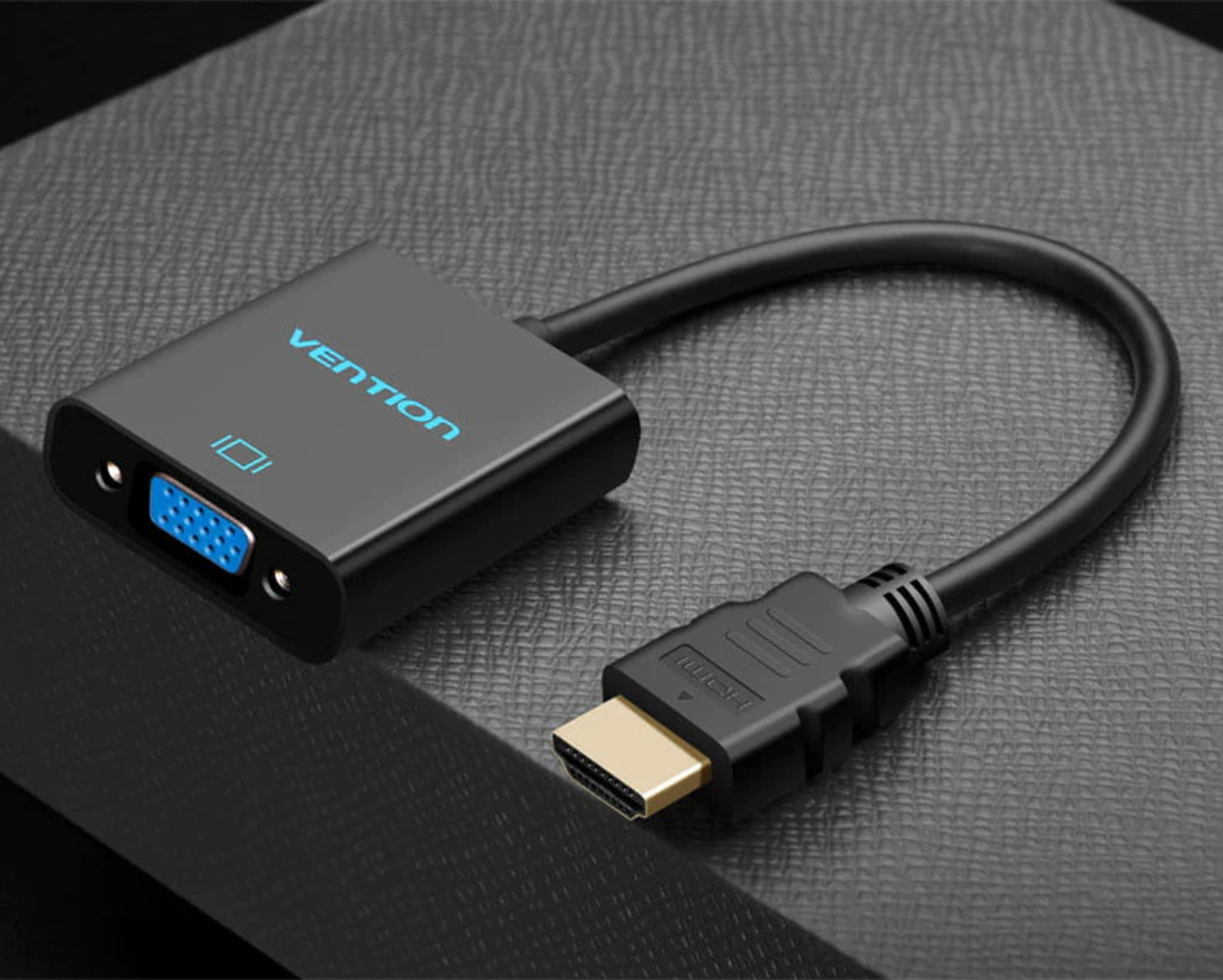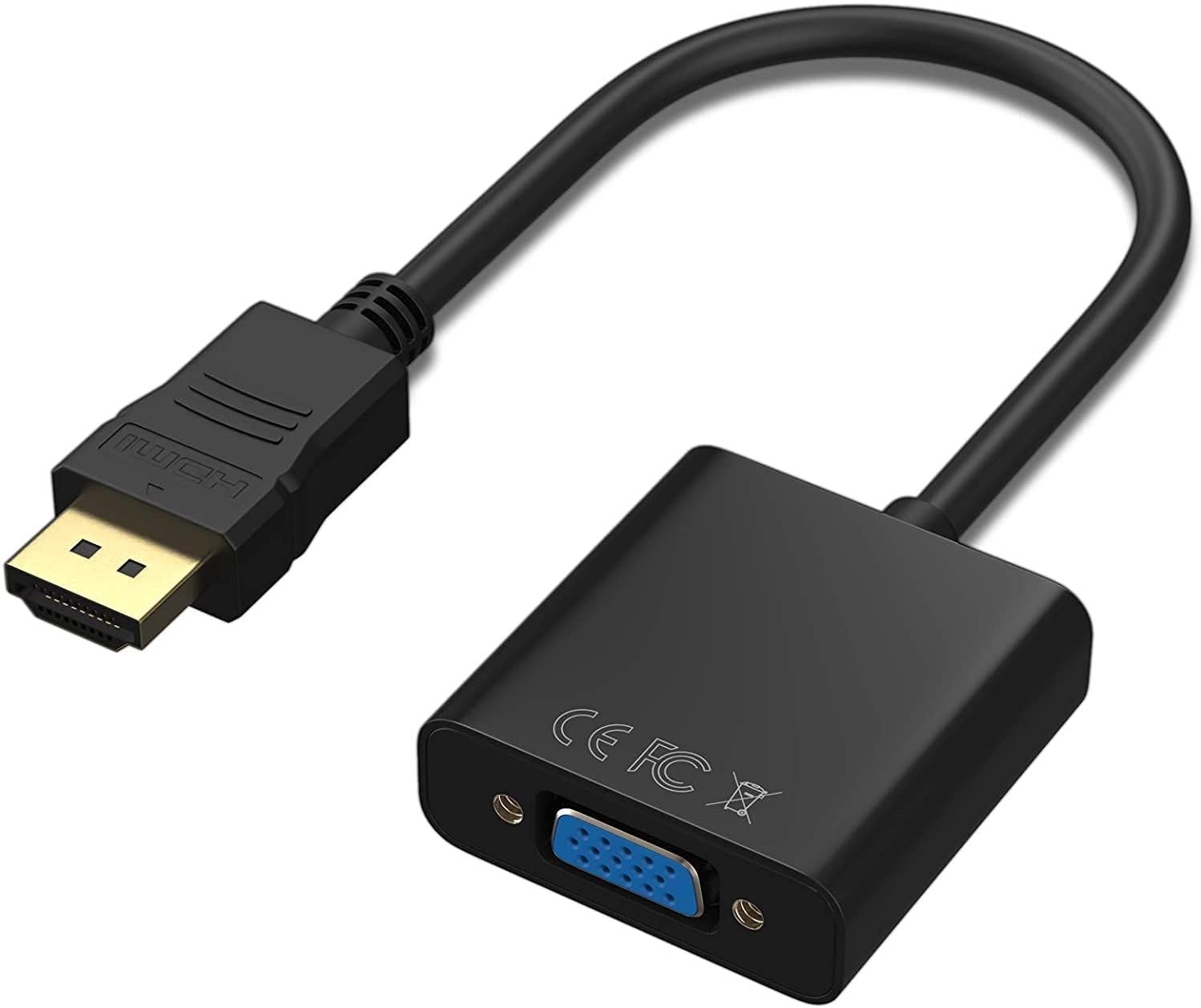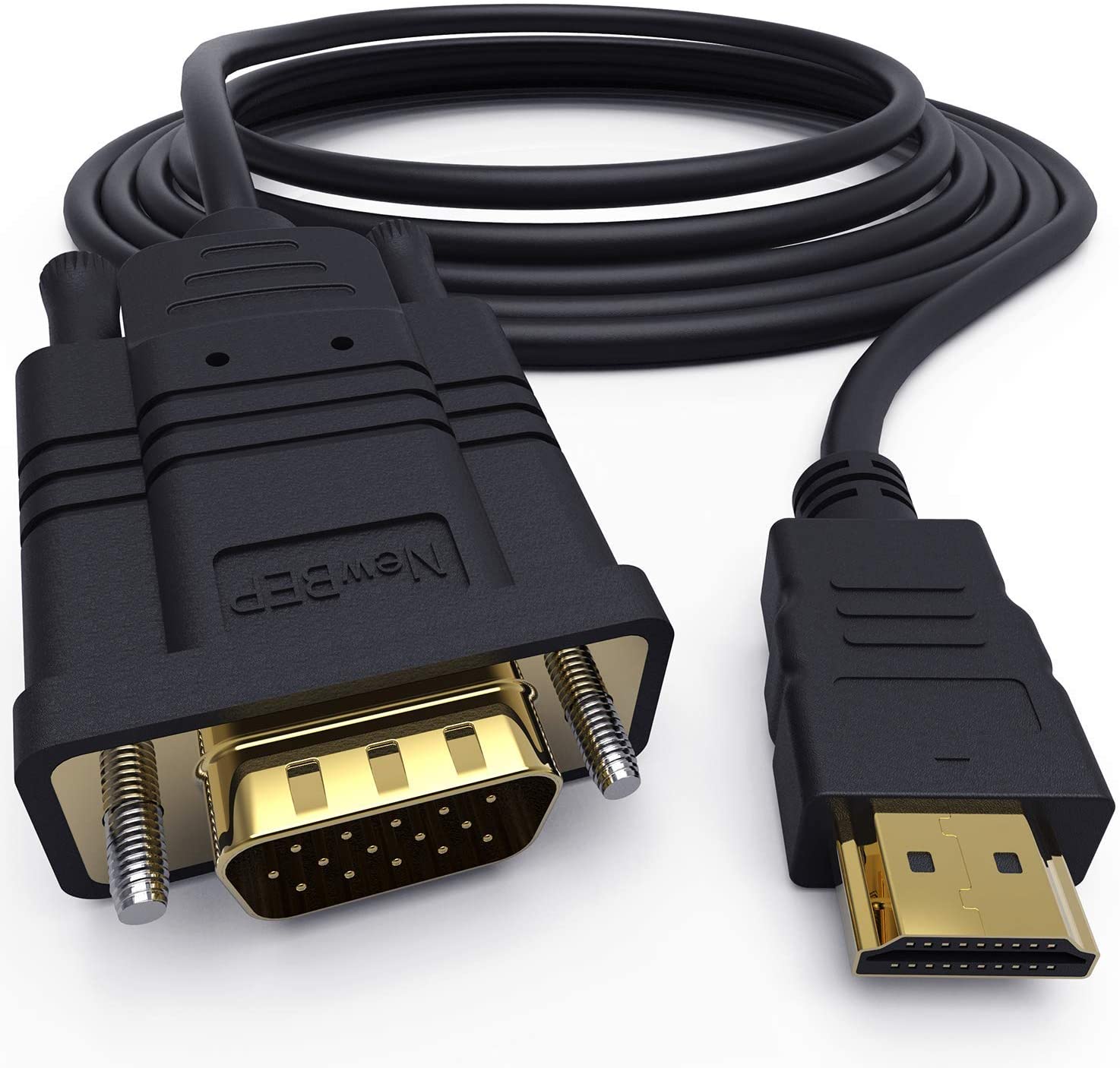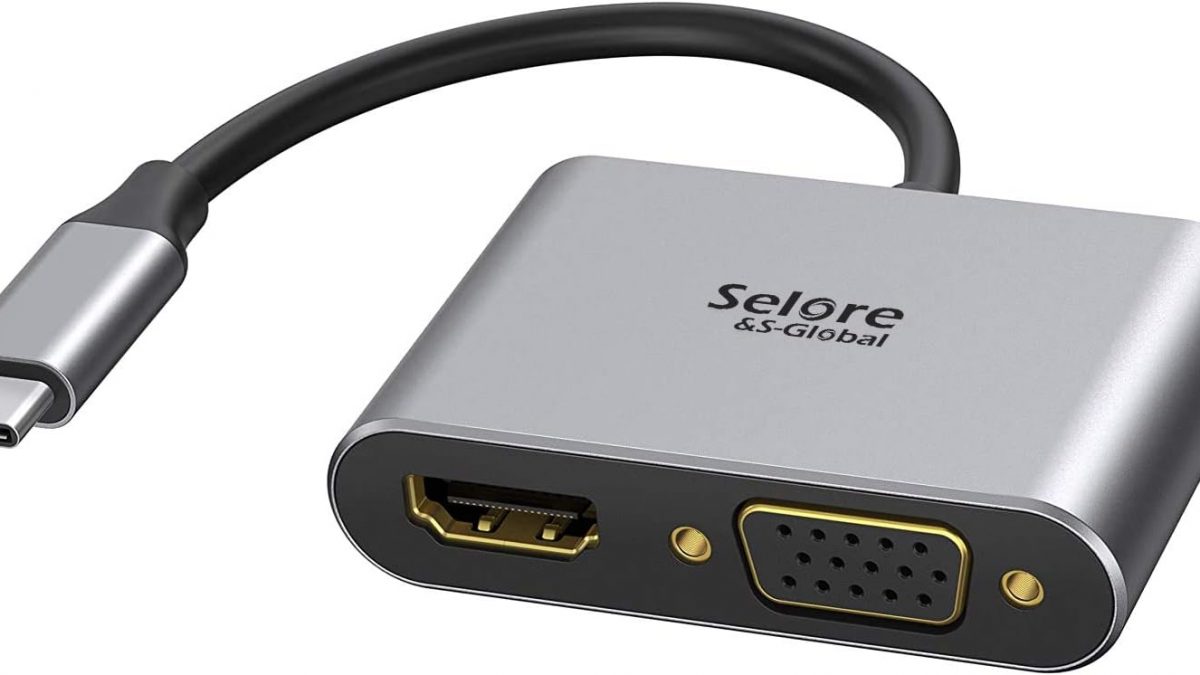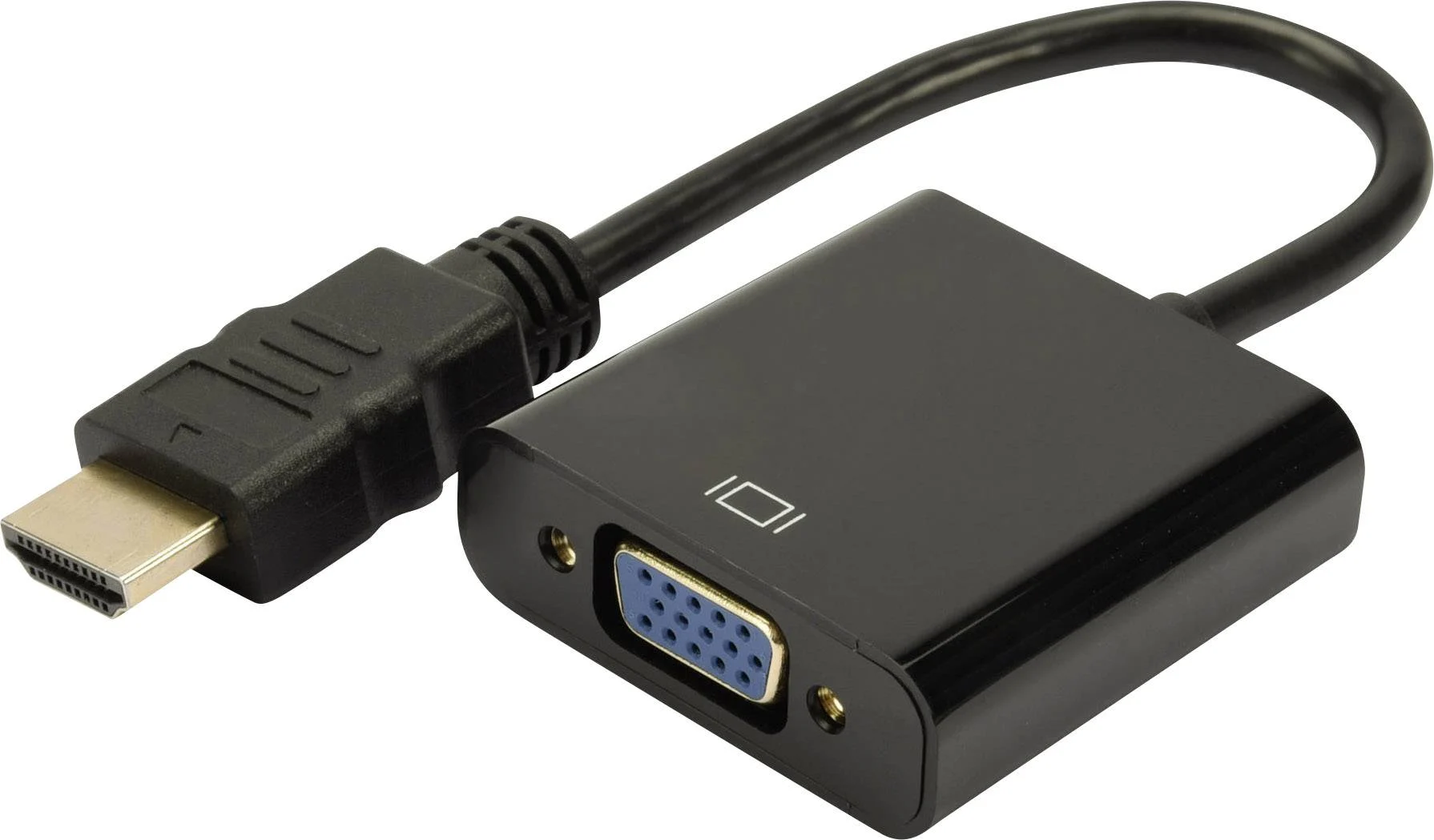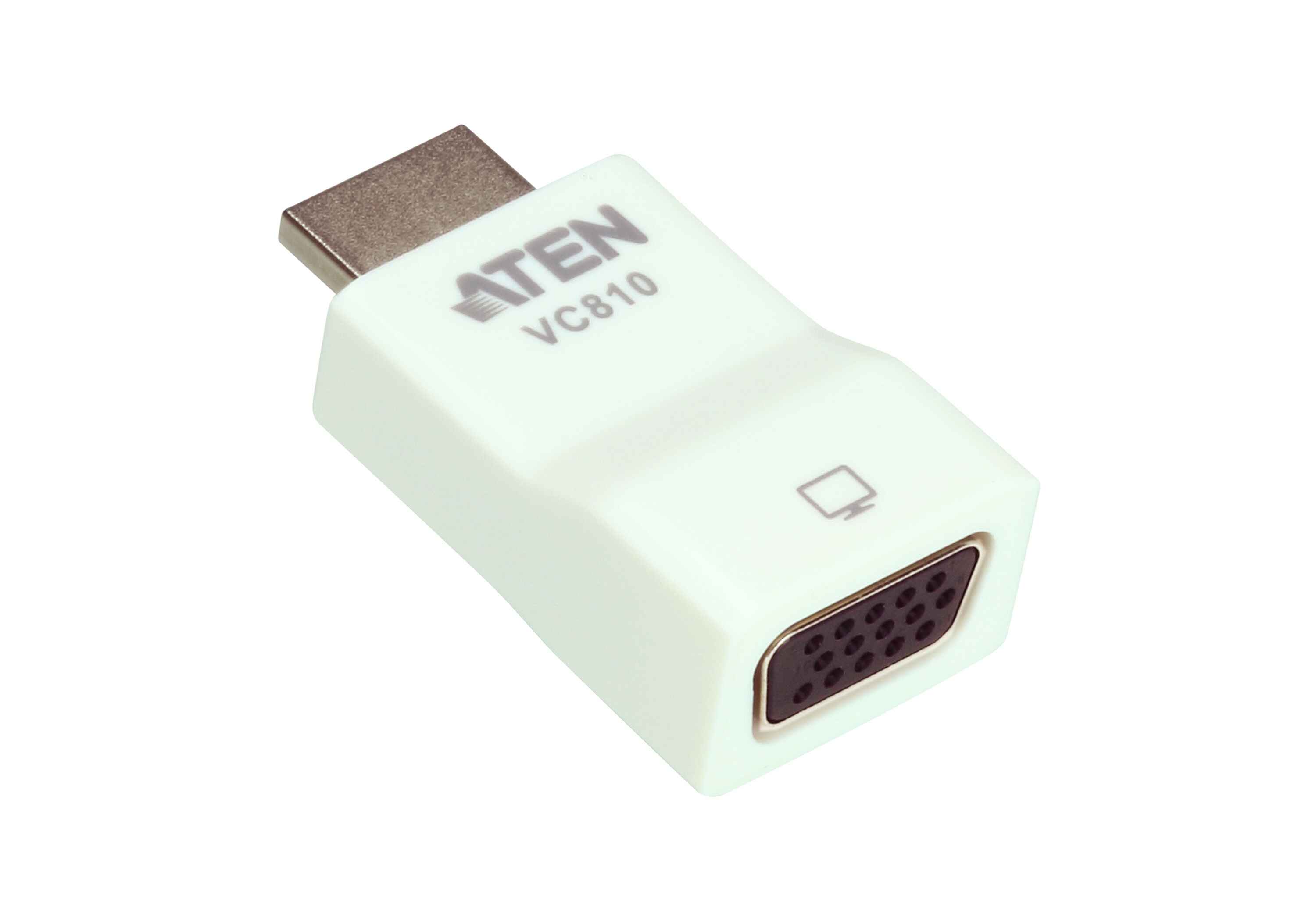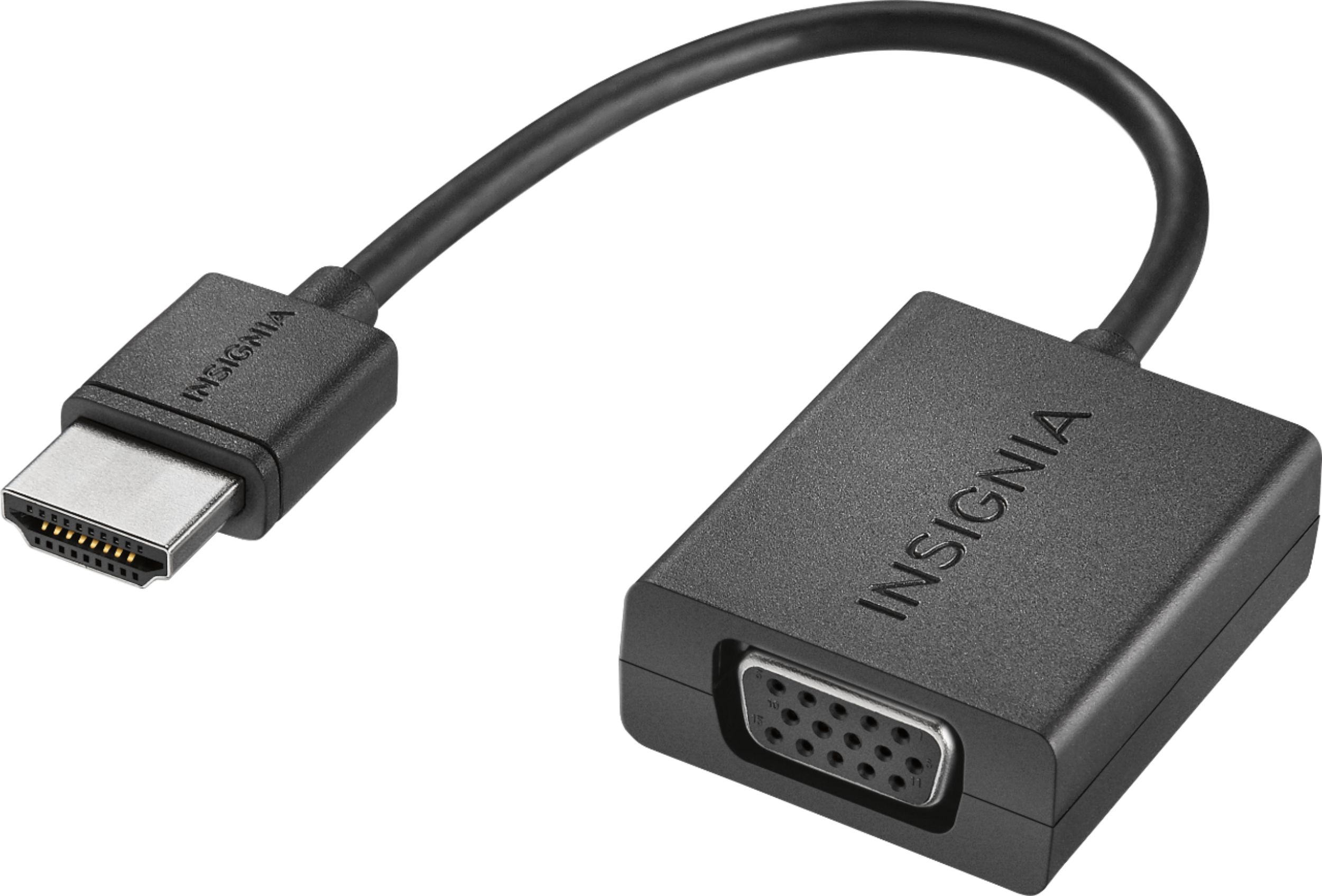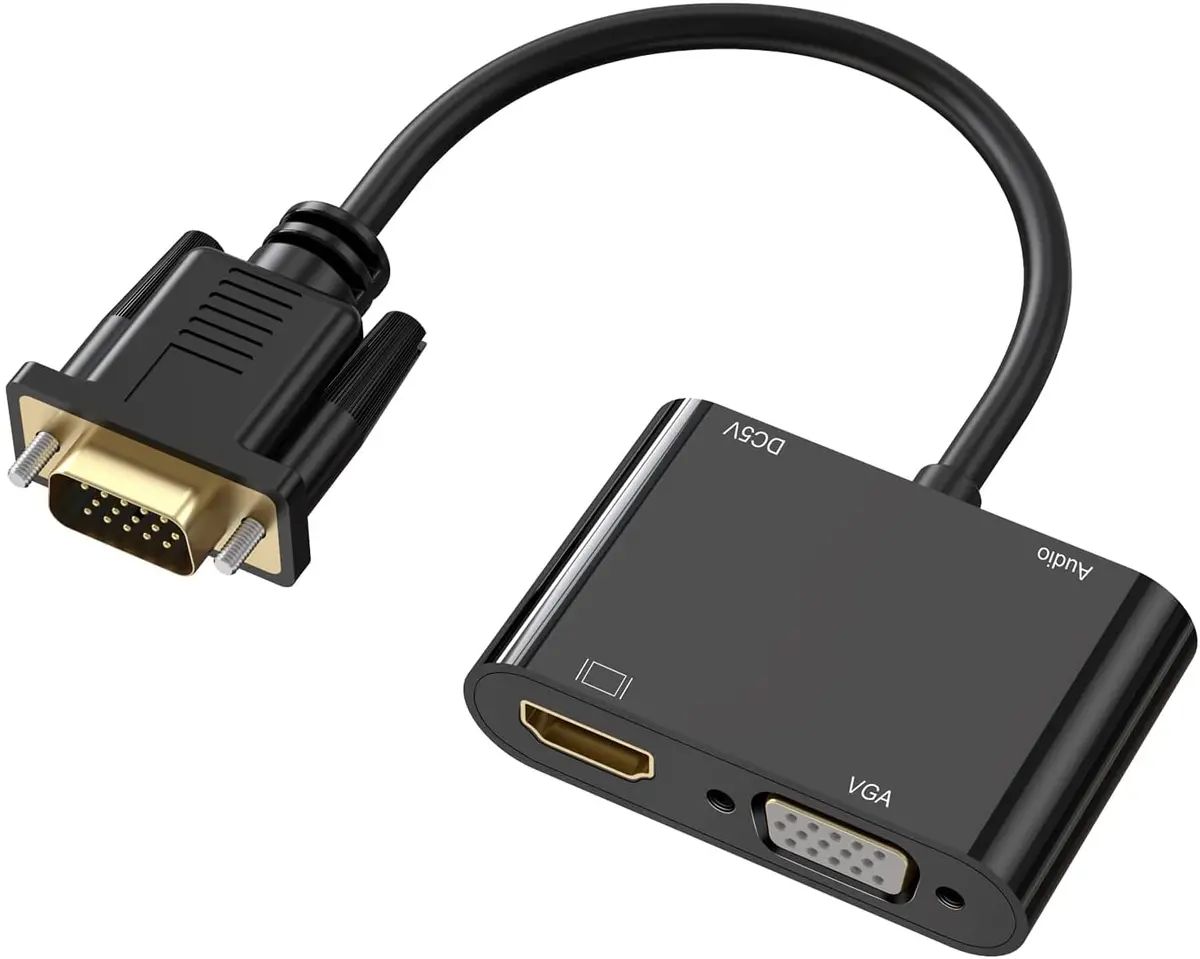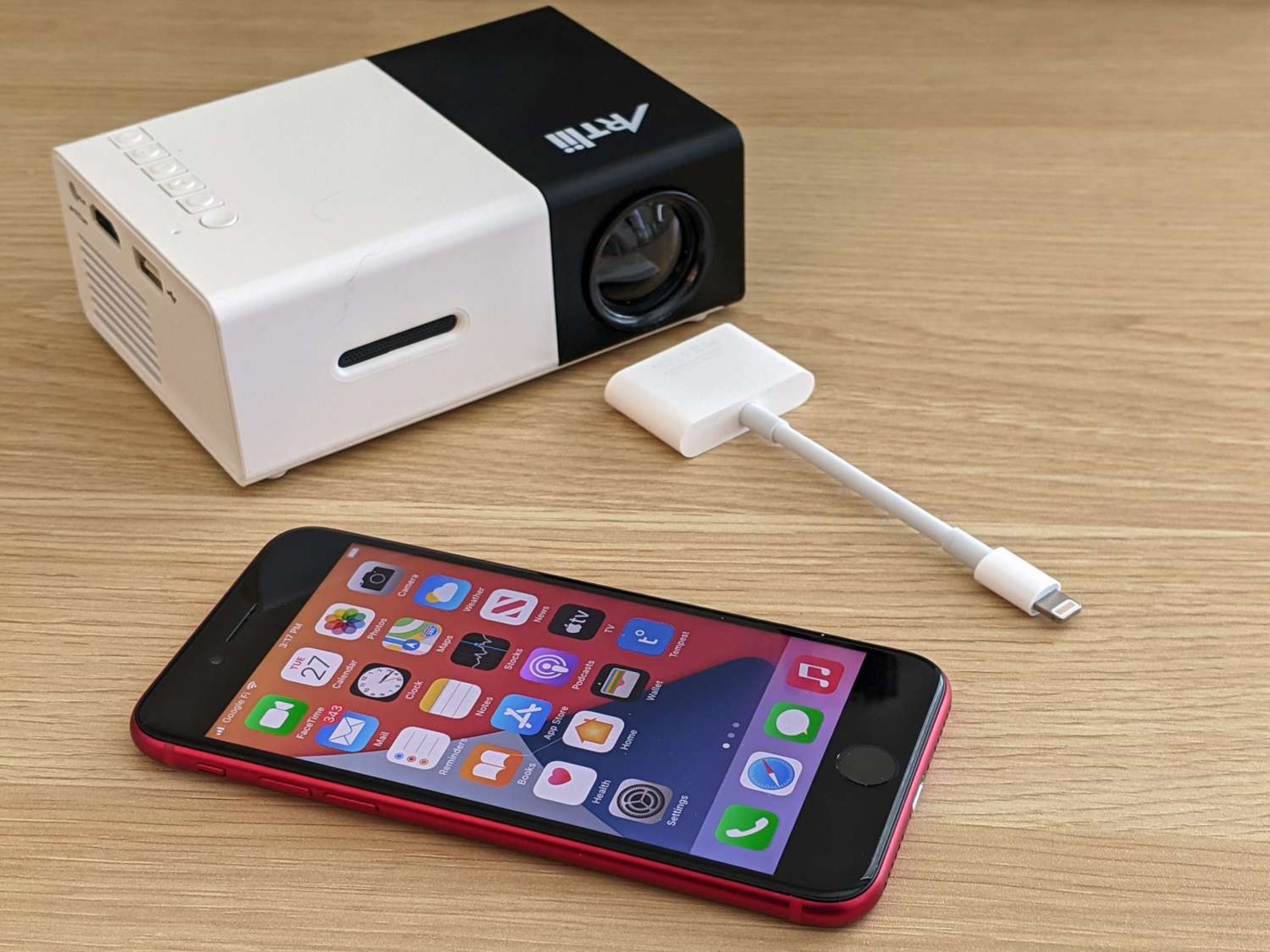What Is A HDMI To VGA Adapter
A HDMI to VGA adapter is a device that allows you to connect a device with a HDMI output, such as a laptop or a DVD player, to a device with a VGA input, such as an older monitor or projector. It converts the digital HDMI signal into an analog VGA signal, allowing you to display the content from your HDMI device on a VGA display.
HDMI stands for High-Definition Multimedia Interface, and it is a digital interface used for transmitting audio and video signals between devices. It has become the standard for connecting high-definition devices, such as TVs, Blu-ray players, and gaming consoles.
VGA, on the other hand, stands for Video Graphics Array and is an analog video interface commonly used in older computer systems and displays. While VGA cannot support high-definition resolutions like HDMI, it is still widely used in various devices and systems, especially in office environments and educational institutions.
A HDMI to VGA adapter bridges the gap between these two interfaces, allowing you to connect modern HDMI devices to legacy VGA displays. It is a compact, portable device that typically has a HDMI input on one end and a VGA output on the other, along with a small set of connectors and pins for signal conversion.
When you connect a HDMI to VGA adapter, it converts the digital HDMI signal into an analog VGA signal, making it compatible with VGA displays. This conversion process ensures that you can still enjoy high-quality video and audio playback, although the maximum resolution and refresh rate may be limited by the VGA display’s capabilities.
Using a HDMI to VGA adapter has several benefits. Firstly, it allows you to repurpose older VGA displays and projectors by connecting modern HDMI devices to them without the need for costly upgrades. Secondly, it provides a cost-effective solution for businesses and institutions that have a large number of VGA displays and want to connect newer HDMI devices.
However, it’s important to note that HDMI to VGA adapters have some limitations. Since HDMI is a digital signal and VGA is an analog signal, the conversion process can introduce some loss in quality. This can result in slight degradation of the image and audio, although it may not be noticeable in most cases.
To connect a HDMI to VGA adapter, you simply need to plug the HDMI end into your HDMI device and the VGA end into your VGA display. Some adapters may also require an additional power source, so make sure to check the specifications and instructions provided with the adapter.
In summary, a HDMI to VGA adapter is a handy device that allows you to connect modern HDMI devices to older VGA displays. It allows you to make the most of your existing equipment, saving you money on costly upgrades. While there may be some limitations in terms of quality, overall, a HDMI to VGA adapter provides a practical solution for bridging the gap between different video interfaces.
Introduction
With the ever-evolving technology, it’s common for us to encounter different types of connectors and adapters when connecting devices. One such adapter is the HDMI to VGA adapter. Whether you’ve heard of it or not, this article aims to shed light on what exactly a HDMI to VGA adapter is and how it can be useful in your digital life.
In this modern era, HDMI (High-Definition Multimedia Interface) has become the go-to standard for transmitting high-quality audio and video signals between devices. On the other hand, VGA (Video Graphics Array) has been a long-standing analog video interface that has been widely used for decades.
The HDMI to VGA adapter acts as a bridge, enabling you to connect newer devices with HDMI outputs to older devices with VGA inputs. It allows you to extend the compatibility of your devices, making them work seamlessly together.
Throughout this article, we will explore the functionality and benefits of using a HDMI to VGA adapter, as well as its limitations. We will also provide a step-by-step guide on how to connect a HDMI to VGA adapter to ensure a hassle-free experience.
Whether you’re a tech-savvy individual looking to connect your laptop to an older monitor or a business professional needing to connect your multimedia equipment to a projector, understanding the capabilities and limitations of a HDMI to VGA adapter will serve you well.
By the end of this article, you will have a clear understanding of what a HDMI to VGA adapter is and how it can enhance your connectivity options. So, let’s dive into the world of HDMI and VGA and discover the possibilities that a HDMI to VGA adapter brings to the table.
What is HDMI
HDMI, or High-Definition Multimedia Interface, is a digital interface that has become the standard for transmitting high-quality audio and video signals between devices. It was first introduced in 2003 and has since revolutionized the way we connect and experience multimedia content.
One of the most significant advantages of HDMI is its ability to transmit both digital audio and video signals over a single cable. This eliminates the need for multiple cables and simplifies the connectivity process. HDMI supports various audio formats, including highly immersive surround sound formats like Dolby Atmos and DTS:X, providing an immersive audio experience to complement the visual content.
HDMI cables come in different versions, with each version offering improvements in bandwidth and capabilities. The latest version, HDMI 2.1, supports higher resolutions, refresh rates, and enhanced color depth. It can handle resolutions up to 10K and supports features like Variable Refresh Rate (VRR) and Auto Low Latency Mode (ALLM) for a smoother gaming experience.
Another crucial aspect of HDMI is its ability to carry copy protection measures like HDCP (High-bandwidth Digital Content Protection). HDCP ensures that copyrighted content is only transmitted to authorized devices, protecting the content owners’ rights.
HDMI is commonly found in devices such as TVs, projectors, Blu-ray players, gaming consoles, and sound systems. It has become ubiquitous in the consumer electronics industry due to its versatility and compatibility.
Overall, HDMI has transformed the way we connect and enjoy multimedia content. Its ability to transmit high-quality audio and video signals, support for advanced features, and simplicity of use have made it a preferred choice for connecting devices and delivering an immersive entertainment experience.
What is VGA
VGA, or Video Graphics Array, is an analog video interface that has been widely used in the computer industry since the late 1980s. It was introduced by IBM as a standard display connector for their personal computers and quickly became the industry standard for video output.
VGA connectors typically consist of 15 pins arranged in three rows, with each pin carrying different types of video signals. This analog interface is capable of supporting resolutions up to 640×480 pixels (VGA resolution) with a refresh rate of 60 Hz.
Initially, VGA was primarily used for connecting computer monitors to desktop computers. However, it has found its way into various other devices, including projectors, televisions, and video capture cards. It became popular due to its simplicity, wide availability, and compatibility across different manufacturers.
Despite its limitations in terms of resolution and bandwidth, VGA has continued to be used in various settings. It remains prevalent in certain industries, such as education and business, where older equipment is still in use. VGA is also commonly found in legacy systems and devices.
While VGA is still widely supported, it is gradually being replaced by newer digital interfaces like HDMI, DisplayPort, and DVI (Digital Visual Interface). These newer interfaces offer better image quality, higher resolutions, faster refresh rates, and additional features like audio transmission.
However, VGA still holds value for certain scenarios. It is known for its compatibility with older devices and its ability to transmit signals over long distances without signal degradation. These factors make VGA a reliable choice for situations where newer digital interfaces are not available or practical.
It’s important to note that when connecting a VGA display to a device that outputs a digital signal, such as HDMI, an adapter or converter is required. This is where the HDMI to VGA adapter comes into play, bridging the gap between the two different video interfaces and enabling compatibility between devices.
In summary, VGA is an analog video interface that has been widely used in the computer industry for several decades. While it may not offer the same level of image quality and features as newer digital interfaces, its compatibility and reliability make it still relevant in certain scenarios. With the HDMI to VGA adapter, users can leverage VGA displays with newer devices that have digital outputs, expanding the connectivity options and ensuring compatibility.
What is a HDMI to VGA Adapter
A HDMI to VGA adapter is a device that allows you to connect a device with a HDMI output, such as a laptop or a DVD player, to a device with a VGA input, such as an older monitor or projector. It serves as a bridge between these two different video interfaces, enabling compatibility and expanding connectivity options.
HDMI, or High-Definition Multimedia Interface, is a digital interface widely used for transmitting high-quality audio and video signals between devices. It has become the standard for connecting modern devices such as TVs, Blu-ray players, gaming consoles, and laptops.
VGA, or Video Graphics Array, is an analog video interface commonly found in older computer systems, monitors, and projectors. While VGA does not support high-definition resolutions like HDMI, it remains prevalent in settings where older equipment is still in use.
A HDMI to VGA adapter is a compact and portable device typically equipped with a HDMI input on one end and a VGA output on the other. It also includes a small set of connectors and pins that facilitate the conversion of the digital HDMI signal into an analog VGA signal.
When you connect a HDMI to VGA adapter, the digital HDMI signal from the source device is converted into an analog VGA signal, allowing you to display the content from your HDMI device on a VGA display. It enables you to enjoy audio and video playback on older displays that do not have HDMI inputs.
Using a HDMI to VGA adapter opens up a range of possibilities. It allows you to repurpose older VGA displays and projectors by connecting newer HDMI devices to them without the need for expensive equipment upgrades. This can be particularly useful in educational institutions, offices, or homes that still rely on VGA technology.
Additionally, HDMI to VGA adapters provide a cost-effective solution for businesses and individuals who have several VGA displays and want to connect newer HDMI devices. Instead of investing in new displays, you can make use of existing equipment, saving both money and resources.
It’s important to keep in mind that HDMI to VGA adapters have some limitations. As HDMI is a digital signal and VGA is an analog signal, the conversion process can lead to slight loss in quality. However, this degradation might not be noticeable in most cases and does not significantly impact the user experience.
To connect a HDMI to VGA adapter, you simply need to plug the HDMI end into the HDMI output of your device and the VGA end into the VGA input of your display. Some adapters might require additional power sources, so make sure to check the specifications and instructions provided by the manufacturer.
In summary, a HDMI to VGA adapter is a practical device that enables connectivity between devices with HDMI outputs and devices with VGA inputs. It allows you to make use of older VGA displays with newer HDMI devices, extending the lifespan of existing equipment and providing an affordable solution for expanding connectivity options.
How does it work
A HDMI to VGA adapter works by converting the digital HDMI signal into an analog VGA signal, allowing you to connect devices with HDMI outputs to devices with VGA inputs. This conversion process enables compatibility between the two different video interfaces.
When you connect a HDMI to VGA adapter, the HDMI input receives the digital audio and video signals from the HDMI source device, such as a laptop or a DVD player. The adapter then converts these signals into an analog format suitable for transmission through the VGA output.
The conversion process involves several components within the HDMI to VGA adapter. One of the essential components is a digital-to-analog converter (DAC), which is responsible for transforming the digital HDMI signal into an analog signal that can be understood by the VGA display.
The DAC analyzes the digital signal, reconstructs it into a wave-like analog format, and outputs it through the VGA output of the adapter. This analog VGA signal can then be connected to devices like VGA monitors, projectors, or other displays that accept VGA inputs.
It’s important to note that HDMI and VGA use different signaling methods. HDMI uses a digital signal composed of ones and zeros, while VGA uses an analog signal that varies in voltage to represent different levels of brightness and color. The HDMI to VGA adapter facilitates the translation between these two signal types.
Additionally, the HDMI to VGA adapter may also include other components to ensure signal integrity and proper conversion. These may include amplifiers or signal conditioners to compensate for any loss or distortion that may occur during the conversion process.
It’s crucial to understand that the conversion from HDMI to VGA is one-way, meaning the adapter cannot convert the analog VGA signal back into a digital HDMI signal. Therefore, the adapter is only suitable for connecting HDMI devices to VGA displays, not vice versa.
Furthermore, it’s worth noting that the audio signals from HDMI are not converted by the HDMI to VGA adapter. VGA does not support audio transmission, so if you want to hear audio while using the HDMI to VGA adapter, you will need to connect a separate audio cable from the audio output of the HDMI source device to the audio input of the display or external speakers.
In summary, a HDMI to VGA adapter converts the digital HDMI signal into an analog VGA signal using a digital-to-analog converter (DAC) and other components. It enables the compatibility between devices with HDMI outputs and devices with VGA inputs, allowing you to connect modern devices to older VGA displays and enjoy audio and video playback.
Benefits of using a HDMI to VGA Adapter
Using a HDMI to VGA adapter brings several benefits and advantages, making it a versatile and practical device for connecting HDMI devices to VGA displays. Here are some of the key benefits:
1. Compatibility: One of the primary benefits of using a HDMI to VGA adapter is the ability to connect newer HDMI devices to older VGA displays. This allows you to repurpose existing equipment, such as monitors or projectors, that have VGA inputs, without the need to invest in new displays. It offers a cost-effective solution for utilizing older technology with modern devices.
2. Cost savings: Instead of replacing VGA displays with new HDMI-compatible ones, using a HDMI to VGA adapter can save you money. This is particularly useful for individuals or businesses with multiple VGA displays, as it eliminates the need for costly upgrades and ensures compatibility between devices.
3. Flexibility: A HDMI to VGA adapter provides flexibility in connecting various types of HDMI devices to VGA displays. Whether you want to connect a laptop to a VGA projector for a presentation or connect a gaming console to an older VGA monitor, the adapter enables you to extend the functionality of your devices and enjoy content on a broader range of displays.
4. Portability: HDMI to VGA adapters are typically compact and portable, making them convenient for travel or on-the-go use. They can easily be carried in a bag or pocket, allowing you to connect your HDMI device to a VGA display wherever you go. This portability makes them suitable for business professionals, educators, or individuals who frequently need to connect devices to different VGA displays.
5. Easy setup: Setting up a HDMI to VGA adapter is generally straightforward. It involves connecting the HDMI end of the adapter to the HDMI output port of your device and the VGA end to the VGA input port of your display. Some adapters may also require an additional power source, but overall, the setup process is quick and hassle-free.
6. Versatility: A HDMI to VGA adapter supports a wide range of HDMI devices, including laptops, gaming consoles, Blu-ray players, media players, and more. This versatility enables you to connect diverse devices to your VGA displays, ensuring compatibility and expanding your options for using different devices with older equipment.
7. Education and business applications: HDMI to VGA adapters are particularly useful in educational institutions and business settings where VGA displays are still commonly used. They enable easy connection of modern devices, such as laptops or projectors with HDMI outputs, to existing VGA equipment. This allows for seamless presentations, lectures, and multimedia experiences without the need for expensive equipment replacements.
In summary, the use of a HDMI to VGA adapter offers compatibility, cost savings, flexibility, portability, easy setup, versatility, and specific applications for education and business. These benefits make the HDMI to VGA adapter a valuable tool for connecting HDMI devices to VGA displays, ensuring seamless compatibility and expanding your connectivity options.
Limitations of a HDMI to VGA Adapter
While HDMI to VGA adapters provide a convenient solution for connecting HDMI devices to VGA displays, they do have certain limitations. It is important to be aware of these limitations to ensure a realistic expectation of the adapter’s performance. Here are some key limitations to consider:
1. Signal quality: HDMI is a digital signal, while VGA is an analog signal. The conversion from digital to analog can result in a loss of signal quality. Although most adapters strive to maintain a high-quality conversion, there may be slight degradation in the image and audio quality, particularly in cases where the VGA display does not support the resolution or aspect ratio of the HDMI source device.
2. Resolution limitations: VGA displays typically have lower resolutions compared to modern HDMI devices. Consequently, the maximum resolution supported by the VGA display may limit the resolution output from the HDMI device. If the HDMI device is capable of higher resolutions, the adapter will downscale the resolution to match the capabilities of the VGA display, resulting in a potentially lower-quality image.
3. Refresh rate limitations: Similar to resolution limitations, VGA displays may have lower refresh rates compared to HDMI devices. The adapter may need to adjust the refresh rate to ensure compatibility with the VGA display, which can result in a slightly different viewing experience, especially for fast-paced content such as gaming or video playback.
4. Audio limitations: VGA does not support audio transmission. While the HDMI to VGA adapter ensures video compatibility, it will not transmit audio signals. Therefore, if you want to hear audio, you will need to connect a separate audio cable from the audio output of the HDMI device to the audio input of the display or external speakers.
5. Unidirectional conversion: A HDMI to VGA adapter only performs the conversion from HDMI to VGA. It does not convert VGA signals back to HDMI. This means that the adapter is only suitable for connecting HDMI devices to VGA displays, and not vice versa. If you need to connect a VGA device to an HDMI display, a different type of adapter or converter will be required.
6. Power requirements: Some HDMI to VGA adapters require external power sources. This can be an inconvenience if you need to use the adapter in situations where accessing a power source may not be feasible. It’s important to check the specifications of the adapter and ensure you have access to the necessary power supply if required.
Despite these limitations, HDMI to VGA adapters still offer valuable functionality for connecting HDMI devices to VGA displays. It is essential to understand their capabilities and work within their limitations to ensure a satisfactory user experience.
How to connect a HDMI to VGA Adapter
Connecting a HDMI to VGA adapter is a straightforward process that requires a few simple steps. Here’s a step-by-step guide on how to connect the adapter:
1. Gather the necessary equipment: Make sure you have the HDMI to VGA adapter, an HDMI cable, and a VGA cable. If your adapter requires external power, ensure that you have the necessary power source and cable as well.
2. Power off all devices: Before connecting any cables, power off both the HDMI source device (e.g., laptop, DVD player) and the VGA display (e.g., monitor, projector). This will prevent any potential damage to the devices during the connection process.
3. Connect the HDMI cable: Take one end of the HDMI cable and insert it into the HDMI output port of your HDMI source device. Ensure a secure fit by gently pushing the connector into the port until it clicks into place.
4. Connect the VGA cable: Take the other end of the HDMI to VGA adapter and connect the VGA cable to the VGA output port on the adapter. Then, connect the opposite end of the VGA cable to the VGA input port of your VGA display (monitor, projector, etc.). Ensure a secure connection by tightening the screws on each end of the VGA cable.
5. Connect the power source (if required): If your HDMI to VGA adapter requires external power, connect the power cable to the adapter and the power source. Ensure that the power cable is securely plugged in on both ends.
6. Power on your devices: Once all the cables are properly connected, power on your HDMI source device (laptop, DVD player) and your VGA display (monitor, projector). It is essential to ensure proper power sequencing to avoid any issues with signal detection or compatibility.
7. Select the correct input/source: On your VGA display, use the display’s menu or settings to select the appropriate input/source. This may be labeled as “VGA,” “PC,” or “Analog.” Adjust any other settings on the display as necessary to optimize the image quality.
8. Check the audio connection: If you want audio to accompany the video, connect a separate audio cable from the audio output of your HDMI source device to the audio input of your display or external speakers. This is necessary since VGA does not support audio transmission.
9. Verify the connection: Once everything is connected and powered on, check that your HDMI source device’s video output is successfully displayed on your VGA display. Adjust the resolution settings on your HDMI source device if needed to ensure compatibility with the VGA display.
That’s it! You have successfully connected your HDMI to VGA adapter and can now enjoy your HDMI source device’s content on your VGA display. Remember to refer to the specific instructions provided with your adapter, as there may be slight variations in the connection process depending on the model and brand.
Conclusion
In conclusion, a HDMI to VGA adapter is a valuable device that allows you to connect HDMI devices to VGA displays, enabling compatibility and expanding your connectivity options. By utilizing this adapter, you can repurpose older VGA equipment, save costs on display upgrades, and make use of existing displays in education, business, and personal settings.
HDMI to VGA adapters provide a range of benefits, including compatibility, cost savings, flexibility, portability, easy setup, and versatility. These advantages make them a practical solution for connecting devices with HDMI outputs to VGA displays, extending the lifespan and functionality of older equipment.
However, it’s important to be aware of the limitations of HDMI to VGA adapters. Signal quality, resolution limitations, refresh rate limitations, audio limitations, unidirectional conversion, and power requirements are some of the factors to consider when using these adapters. Understanding these limitations will help manage expectations and ensure a satisfactory user experience.
To connect a HDMI to VGA adapter, gather the necessary equipment, power off your devices, connect the HDMI and VGA cables, connect the power source if required, power on the devices, select the correct input/source on the VGA display, check the audio connection, and verify the connection by ensuring the content from the HDMI source device is displayed on the VGA display.
In summary, a HDMI to VGA adapter is a versatile tool that facilitates connectivity between HDMI devices and VGA displays. It offers a cost-effective solution for using newer devices with older displays and opens up a range of possibilities in various settings. By understanding the benefits, limitations, and proper connection procedures, you can make the most out of your HDMI to VGA adapter and enjoy seamless compatibility between different video interfaces.







